#sarimanok
Explore tagged Tumblr posts
Text
ABS-CBN Sarimanok Logo (1960s-1970s)

Created this recreation of the partially-lost Sarimanok color logo from the 1960s-1970s as it would've appeared on TVs. Not perfect, but could be close enough to the real thing.

This is another variant of the image I made with a filter. This is how I imagine it may've looked like on color TVs of that era.
#my art#abs-cbn#philippine media history#media history#historical media#lost media#recreation#1960s#1970s#sarimanok
3 notes
·
View notes
Text

ABDULMARI ASIA IMAO Pambansang Alagad ng Sining para sa Sining Biswal-Pagpipinta (2006) Seryeng Sarimanok, akriliko sa kambas, 2012 #artPH
#abdulmari asia imao#sarimanok#seryeng sarimanok#sarimanok series#larawang-pinta#painting#akriliko sa kambas#acrylic on canvas#pambansang alagad ng sining#natioanl artists of the philippines#NationalArtistsPH#sining biswal#visual arts#filipino art#artPH
5 notes
·
View notes
Text

Trying to decide which body color I like most for my chibi sarimanok. What do you think?
1 note
·
View note
Text

AYEEE HI thank you for the tags!!! glad to contribute to the SEA representation >:3c LET'S GOO 🤝
also I wanted to take some time talking about their real name, which is in fact Adarna Panganiban! Honestly I'm not quite sure if I'll give them a real backstory concerning their identity... I crossed out their name in the first place in the chance that they had a reason to keep it secret...
...BUT I'm really proud of this name because of the meaning behind it: Adarna is the name of a legendary bird in a Filipino epic - it's also been compared to the phoenix a couple times! And the root word for Panganiban is panganib, the Tagalog word for danger. They're just a danger bird lmao


IEYTD guys for your consideration! My Agent Phoenix + four guys who may or may not be friends. It's still a little unclear. You can read more info about them over here!
#i Usually like giving my oc names meaning#phoenix schaden and mamba (sorta) have these deeper meanings#mina and franz i just. liked the name lol#magpantay is an existing character's name (kinda common PH surname#it means 'to straighten/match/equal' ? depending on usage)#i havent. read the epic in a very long while#but it's a thing i prommy. it's very long#another legendary bird is sarimanok. colorful lil thang#last note . marshall is my token white girl apparently LOL
210 notes
·
View notes
Text
francislibiran: Emmy and Golden Globe Award winner Darren Criss (@ darrencriss) debuts in a custom Francis Libiran Barong at the premiere of his new Broadway musical, MAYBE HAPPY ENDING.
Crafted from Piña Jusi fabric and paired with off-white Italian wool pants, this piece is a tribute to Darren Criss’ Filipino heritage as it showcases intricate beadwork and embroidery inspired by a symbol of good fortune, the Sarimanok of the Maranao people. #DarrenCriss #MAYBEHAPPYENDING #FrancisLibiran
#darren criss#francis libiran#maybe happy ending broadway gala#maybe happy ending#maybe happy ending bway#instagram#video#nov 2024
39 notes
·
View notes
Text
Gubat Banwa: THE SULTANATE OF AKAI

LUNAR KNIGHTS. CHIVALROUS POETS. FAITHFUL PANDITA. One of the most powerful mahamandalas in Gubat Banwa, conquering in their Divine Striving for Goddess, is inspired by the various Sultanates of Southeast Asia! STRIVE EVERMORE FOR GODDESS: AKAI!
While Akai is host to a huge number of religions, their culture and allied polities are skewered through with belief and utmost reverence for The Most High Baginda, BAGINDA SUMONGSUKLAY, which is not her name but a descriptor as the Crescent Moon.
Akai reverses the use of God and uses "Goddess" instead. They are a primarily matriarchical culture, and they believe that Goddess lives on the Moon. The Moon is the most important thing in the universe: it is the hole that leads into the True Space of Goddess.
Akai is intensely researched and inspired by popular Postclassical Southeast Asian societies: Malacca, Johore, Maguindanao, Sulu and more. They are raiders far and wide, and fight so that all of Gubat Banwa will know of the providence of Goddess.
Their faith, AGMA DAMLAG, is inspired by Southeast Asian Islam, which is skewered through with mixtures of local folklores and legends, making it different from "pure" Islam. It is filled with mysticism, jinns, and devil dancers.
Their Disciplines are focused on overwhelming and protecting, on defense. They are the unbreakable ones, after all! They are also inspired by Islamic Chivalry notes: it is the Sultanates that house the most court romance, poetry, and chivalry.

BEAST HUNTERS are those that turned the common profession of hunting in the Isles into an actual martial art. Out of necessity: Beast Hunters are quick and debilitating. According to their Faith, they cannot allow their dogs to bleed the prey before they do.
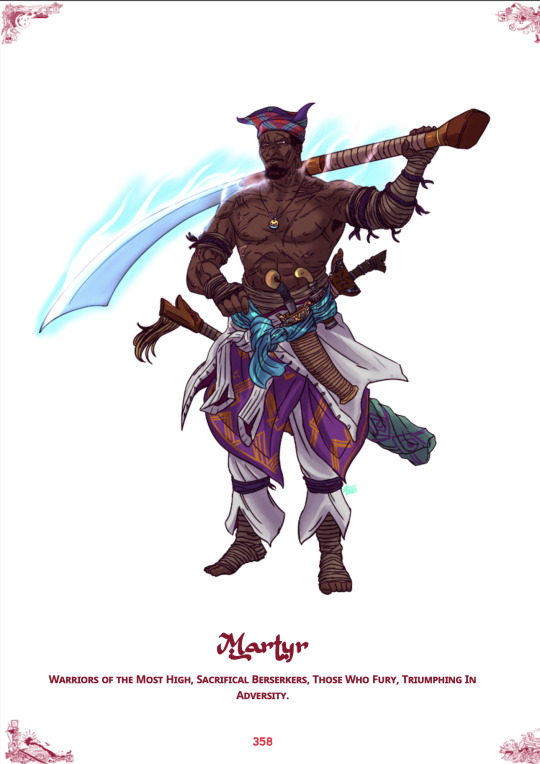
the MARTYRS are warriors that go into battle in a fierce death battle trance, always ready to die for their convictions. they get stronger as the fight goes, and their techniques let them strengthen their attacks, throw their giant weapons, go into holy rage, and wield juru pakal

SARIMANOK KNIGHTS are true chevaliers who wield the strength of the sarimanok--a revered omen bird that is integral to many cultures of the sword isles--to punish and smite those that would force them to kneel! they can fly upon sarimanok, or be imbued with the holiness of one

STRIFESINGERS sing the grand dirge of Gubat Banwa, as it revels in violence. they are constantly singing: they have a burst 2 aura that constantly heals and gives buffs, and they can put down grand songs that manipulate allies and the battlefield!
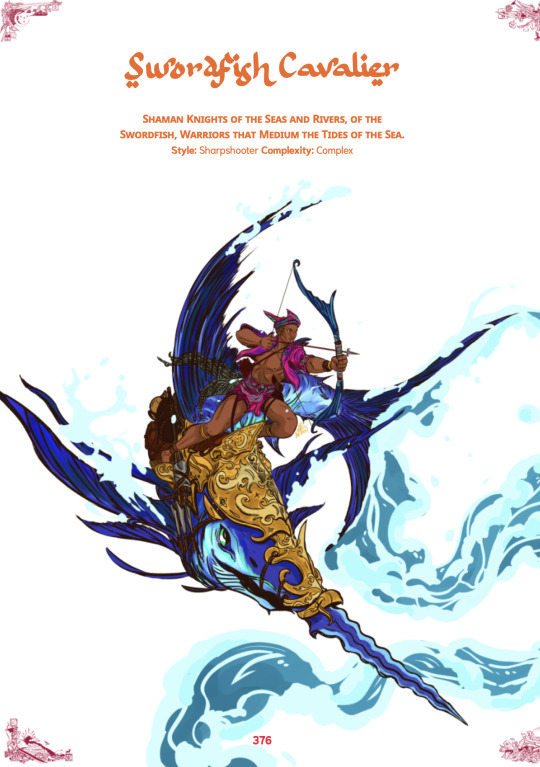
warriors that summon the knights of the sea: churning the waters with swordfishes and sharks are a common element in seasian folk tales. the swordfish cavalier is the purest representation of that, allowing them to manipulate water, turn into water, or summon the moon
All of these and more in our KS. Back us now and help us get more art and writing for this grand mahamandala!
Just as important: in solidarity with our colonized and oppressed peoples in Palestine! From the river to the sea, Palestine will be free! Check out this ongoing fundraiser that has over 250+ games for Gaza!
92 notes
·
View notes
Text
instagram
francislibiran: Hollywood star Darren Criss (@darrencriss) pays homage to his Filipino heritage with a stunning entrance wearing a custom Sarimanok Barong at the premiere of his Broadway musical, MAYBE HAPPY ENDING. The Francis Libiran ensemble features intricate beadwork and signature art deco embroidery, bringing the mythical Sarimanok—an emblem of good fortune and strength for the Maranao people—to life. #DarrenCriss #MAYBEHAPPYENDING #FrancisLibiran
9 notes
·
View notes
Text
Alrighty wonderfolks! Time for some
Small
Info about Iris Adarna herself!
If ya don't know what's Yaelokre, it's an amazing illustration of songs by four characters! Go to @yaelokre if ya want more to know!
Now on with my yaelokre OC!

This is Iris Adarna! She is the passionate dancer and Songbird of the forest!
She is mostly based off of one of Philippines famous mythology birds Ibong Adarna! The Philippine trogon's vivid colors earned it the nickname "Ibong Adarna". The Ibong Adarna is often described as the most colorful bird in Philippine folklore. It is also thought to share a resemblance to other legendary birds such as the Sarimanok and the phoenix. (But in my OC'S au,the three are all cousin's)
Her purpose like the the legendary colorful bird is that Ibong Adarna is a quest that teaches us that perseverance and generosity empower us to reach our dreams!
The Adarna bird is the namesake mythical bird from the Filipino story Ibong Adarna in which the bird is sought after for its magical powers. The Adarna bird has the ability to sing seven songs of enchantment and can put people to sleep, turn objects to stone, or perform miraculous healing
Iris sings across the Forests,fields and meadows, being a travelling songbird that can heal people through her seven songs (such as o maliwanag na buwan, mabuhay, love letters, going to richmond, Speak no evil and Golden slumbers/she's leaving home)
Her pastime/hobby is singing different songs across her path as she dances gracefully, but be careful with what intentions you may bring upon my little songbird, she could sense and see through you and will bring out your true colors! (Dun,dun,dun!)
Welp! That's all I got to give about my yaelokre OC! More art of her may come in the near future!
@blo0st4r @vexic929 @kenakostarcat16 @scally-wiggles716 @bbjxencanto-blogger @boltthevolt @sprinklehere @baxstarmallow06 @purpleselfships @iookingle3rd @hotelcaliforniaenbydancer @chibitacolord @undertale-person
Special thanks again for @yaelokre for giving such wonderment and passion for us wonderfolks!
9 notes
·
View notes
Text

OC of a punk rooster named Moe - based on a mythical Filipino rooster aka the Sarimanok. An old OC for a Webtoon that I stumbled upon that seemed fun to redesign
4 notes
·
View notes
Text
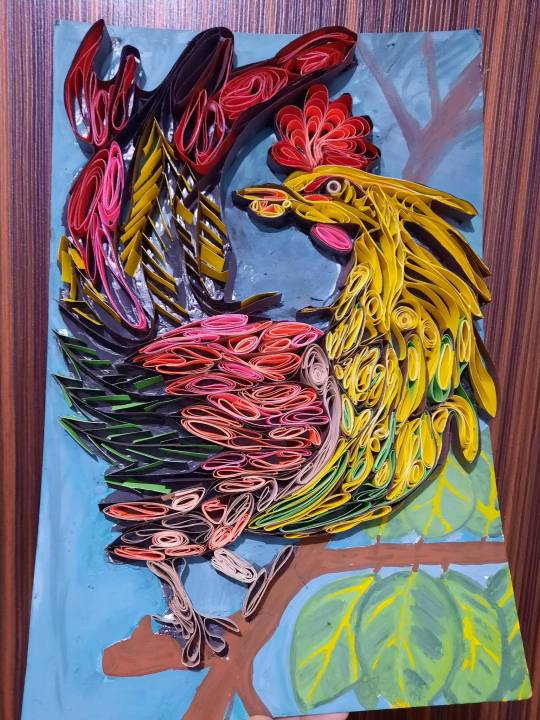
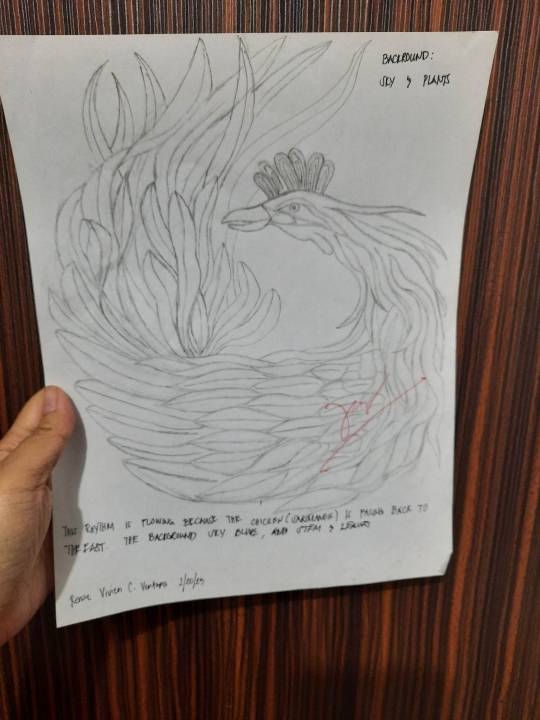
Favorite Artwork and sketches. Paper Quilling
Philippine Mythology: Sarimanok (Legendary Bird)
HAVE A NICE DAY CHICKENS.
#chicken#nostalgia#filipino mythology#legendary creature#philippines#art appreciation#art#traditional art#paper quilling#college life#so fine
2 notes
·
View notes
Text
i need to create article notes and a presentation and a video about my history article and i don't fucking know how. or i guess i can't do it.
Lico, G.R.A. (2017). Rising from the Ashes: Post-war Philippines Architecture. Docomomo 57
anyways. after wwii and as the philippines became independent, manila was devastated (2nd most devastated allied city after warsaw in fact). so they gotta rebuild and build y'know? people saw modernism as a new way to develop this new nation and make it look different from old colonial styles. also they needed to cut down costs and build them as fast and efficient as possible, so they did away with fancy ornamentation. so modernism fit that nicely.
there was a US war rehab fund to rebuild notable manila buildings, mostly government buildings, and also those in my university. later there would be a campus built in quezon city (though before it was called quezon city) and it's. well. more developed imo
there were plans to build a capitol complex too, in quezon city (since the capital was moved there). but it wasn't finished.
so a lot more buildings were built in modernist style. many had glass walls and super cubic and geometric shapes. there were also big domes built (like araneta coliseum) and also places of worship had big geometric shapes too (like the main aglipayan church and the iglesia ni cristo churches).
there were also suburb subdivisions made, influenced by american ones and their car culture, and also high-rise condominiums. there was a high-rise boom in manila and also makati (which still has a bunch of high rise buildings to this day).
except... people realized that this was Nawt energy efficient. they needed lots of aircon and ventilation to cool buildings (this is the philippines after all, it's hot). so they changed stuff. architects adapted slats on the outside (brise-soleil and similar structures) to lessen sunlight and heat and help with ventilation. slanted roofs and windows, similar to the bahay kubo, were later used. so basically architects started taking details from traditional filipino houses and modernized them in a way. this is called tropical regionalism.
then when the marcos sr. administration came around, they started incorporating a bunch of indigenous motifs from all over the country for aesthetics, and to create a "national architecture". this was mostly headed by imelda marcos. so like the sarimanok and naga motifs and much more. lots of big buildings were constructed, mostly with leandro locsin as architect.
after the marcoses were deposed, postmodernism took over (though the article doesn't go deep on the buildings in this style). the people wanted something different from the marcoses' blatant displays of wealth and prestige. (look. they sucked.)
so a bunch of modernist buildings were demolished, until a law was passed to protect and preserve some of these and also the country's heritage sites.
#now the thing is. HOW DO I DO THIS FORMALLY#like how do i make an outline of this essay with no sections#because i think our prof wants a proper topic outline#anyways. post war ph architecture be upon ye#lucie.txt
0 notes
Text

ALVIN BUENO, JR. Sarimanok, akriliko sa kambas, 2023 #artPH
#alvin bueno#alvin bueno jr#sarimanok#larawang-pinta#painting#akriliko sa kambas#acrylic on canvas#sining biswal#visual arts#filipino art#artPH
4 notes
·
View notes
Text

Finished my chibi sarimanok drawing. I love it so much! The sarimanok is a bird from filipino folklore (more specifically the maranao people). It is usually depicted as a large chicken with colorful feathers and a fish hanging from its beak. The sarimanok is a symbol of good fortune
6 notes
·
View notes
Text
The Maranao Culture and Tradition
DMITRI ETHAN C. BELANDRES, B. S. PHAMACY 1-A
@evienovich / evienovich.tumblr.com
If there is one tribe that can arouse your interest, try discovering the Maranao Tribe, a Muslim Tribe that adheres to Islam Belief. The Maranaos are known to inhabit most of the municipalities of the province of Lanao del Sur and Marawi City, its capital. Visit and see for yourself how the culture and tradition of the Maranaos stay compact, and amazingly resilient against outside influences.
One of the Islamic Muslim Tribes in the Philippines which has sustained its culture and tradition even in the modern days is the Maranao Tribe. The term Maranao literally means “People of the Lake,” with reference to the location of the Tribe’s habitat immediately contiguous to Lake Lanao, south of Marawi City, in the province of Lanao del Sur, and one of the Bangsamoro Regions.
The Maranaos, as they are called, have their own spectacular culture and tradition peculiar to them which make them stand out from other Muslim Tribes. They are known for their metal crafts, architecture, colorful dances, cultural attire, tapestry, distinctive cuisine, and epic literature.
One of the most popular art manifests of the Maranaos is their vivid color combinations. This taste of art that displays bright, eye-catching colors attracts not only the locals but even foreign visitors who came to know their art. This eye-catching color combination taste which they integrate with their other forms of artistry, is truly amazing and captivating.
Among the most distinct and an essential trademark of the Maranaos’ art forms is the Sarimanok. The Sarimanok is a legendary bird that serves as the symbol of the Maranaos. Sarimanok came from the words “sari” (a garment of different colors deeply related to their culture) and “manok” (rooster with its beautiful and colorful feathers), believed to represent good fortune and prosperity, a symbol that the Maranao people in the Philipines are associated with, and a significant part of Maranao people’s cultural heritage.
SARIMANOK
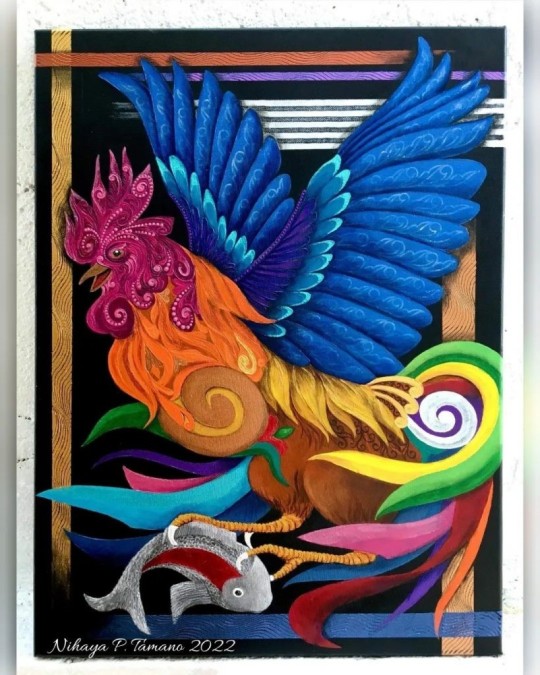
CULTURAL DANCES
Another art form of the Maranaos which also made an impression in their distinct culture and tradition are their dances. The cultural dances also showcase the Maranao’s ingenuity. Performing these dances highlight certain celebrations such as during festivals and occasions intended for entertainment. Their trademark prevails in the use of ornate colorful costumes and instrumental music. Their dances were created from the Darangen, an ancient epic of the Maranao community.
One of their famous dances include the Kappa malong-malong which is also known as Sambi sa Malong. This is a cultural dance where dancers show the several ways of using malong. It portrays how malong is worn with the fabric combined of many bright colors, an identity of the Maranaos’ taste of colors. The meaning of the dance lies in the aim of partaking the usefulness of malong that to fully absorb the steps of this dance, one must learn and understand the significance of malong – a simple tubular yet highly functional piece of cloth for all Filipino-Muslim.
KAPPA MALONG-MALONG
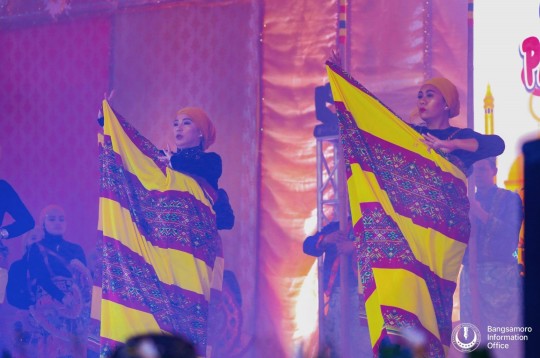
Another popular dance is the Singkil, a royal dance where the woman gently steps in and out of the clipping bamboos while holding a fan. The woman dancer wears an elegant colorful costume as the main dancer. Its music is by the sound of a gong, an original sound intended for the dance. This dance is one of the proofs of Maranao’s original dances which identifies them from other tribes, a true Maranao pride.
SINGKIL

Along with the art forms like the Sarimanok and the dances reflective of the Maranao culture and tradition is the Torogan which literally means a resting or sleeping place. It is a traditional ancestral house symbolizing a high social status or nobility among Maranao People. This pre-colonial house was home of the royal blood whose positions in the community were that of sultans or datus deemed political leaders looked up with great respect by their respective constituents.
The Torogan portrays the ingenuous architectural prowess of the Maranaos. One of the last standing Torogan and the only remaining habitable structure was declared as a National Cultural Treasure by the National Museum of the Philippines in 2008 which can be found in Bubung Malanding, Marantao, Lanao del Sur. This structure was built without the use of nails only fitted joints and fiber lashings.
It is one of the attractions and pride of the Maranao Tribe as it reminds them of the historic deed of their brave leaders who withstood Spanish conquest. The Torogan symbolized rank, power and prestige.
TOROGAN
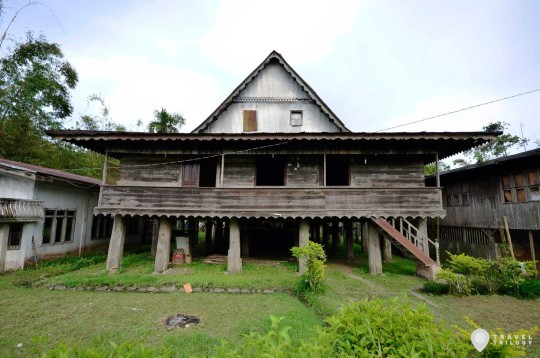
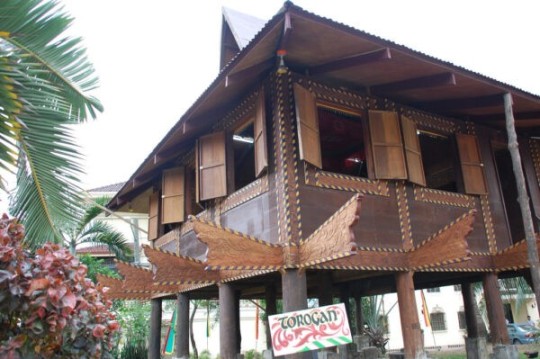
Torogans were elevated from the ground using “tukod” or hard tree trunks of huge girths. At the center is the “tapuwilih” post surrounded by twenty-five others at the base.
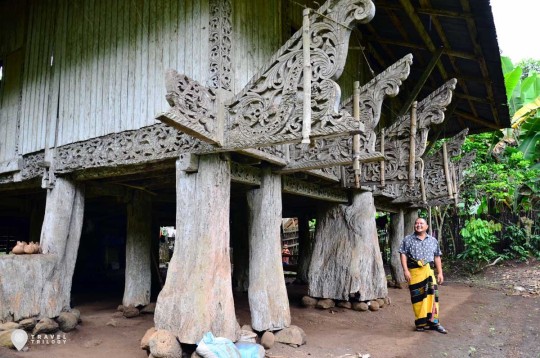
Another part of the culture and tradition of the Maranaos is their distinct taste of food. They have a different choice of food and preparation. Travelers from neighboring provinces and students of the Mindanao State University (MSU) have been privileged to taste the delicacies peculiar to Maranao Tribe. Their famous cultural delicacies include the sakurab. It’s made with palapa (dried coconut shavings and dried chili), local native scallions and chili, a common appetizer for the Maranaos.
Known for love of spicy flavors, most of their food are indeed hot and spicy. The palapa also serves as a mainstream ingredient in most of their popular dishes like pyaparana manok (chicken with coconut meat), beef randeng (beef with coconut), bakas (tuna fish), and badak (jackfruit) with coconut milk and powdered turmeric [kalawag], which adds a yellowish color that sets their food apart food from other Muslim Mindanao cuisines.
During their month-long celebration, Maranao’s special ‘kakanin’ delicacies also highlight the event, most of which are made from sticky rice flour with coconut milk and brown sugar such as dudol, tamokansi, tiyatag, pabrot, and many more.
MARANAO CUISINE
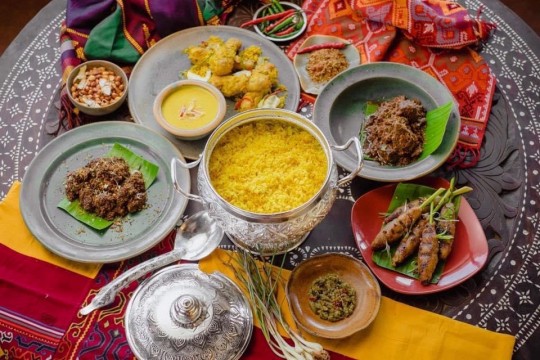
The traditional clothing of the Maranaos goes with their art form display of colorful, handwoven clothes. A known conservative tribe, women wear tightfitting short blouses and narrow cut pants resembling breeches and a wrap-around material to make certain that their bodies are fully covered. Men on the other hand, also wear narrow cut pants and wraps a sash-like cloth around the waist where he places his weapon – usually a long knife.
MARANAO CLOTHING
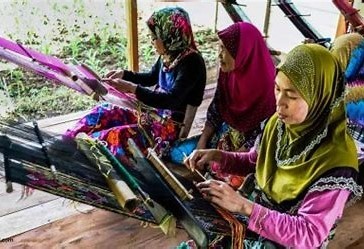
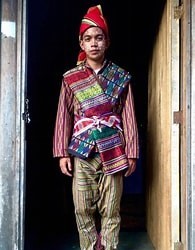




The traditional clothing of the Maranaos goes with their art form display of colorful, handwoven clothes. A known conservative tribe, women wear tightfitting short blouses and narrow cut pants resembling breeches and a wrap-around material to make certain that their bodies are fully covered. Men on the other hand, also wear narrow cut pants and wraps a sash-like cloth around the waist where he places his weapon – usually a long knife.
Start satisfying your curiosity and witness in reality this one Tribe that exhibits a distinguished way of life. It is worth knowing that a certain tribe has been able to preserve its culture and tradition despite the changes of times. It is an overwhelming experience to actually see these people’s unique culture and tradition and truly inspiring to note how they sustain such amazing culture and tradition. This is what makes the Maranao culture and tradition impressive and worth discovering.
1 note
·
View note
Text
Artist research: Whang od
For this project, I have taken inspiration from the Filipino artist Whang-Od, a lady that started tattooing from the young age of 15. She first learned from her father, breaking stereotypes of women using her exceptional talent and skill potential that her father believed she possessed. Her art originates from the Mambabatok culture, incorporating designs like eagles, for warriors who killed enemies, python skin and other geometric designs.
Whang-Od began tattooing and travelling far to villages around the Phillipines. Many communities would request for her to imprint symbols carried through their ancestry to individuals reaching a significant point in their lives. For men, she would do bikking tattoos, a chest tattoo that stretched over the shoulders and arms, taking several days to complete and in return, the individual paid in food, rice or a large pig. Women were also tattooed, to show fertility and beautification. As for tattooing materials, she would use completely organic and naturally sourced materials, consisting of charcoal and water that is pricked into the skin using thorns from calamansi or pomelo. This is known as batok and is actually a lot more painful of a method than modern tattooing techniques. She then adapted a signature tattoo in 2017 that consisted of three dots, symbolising herself and her blood-related apprentices and also the next generation in her art.
Every tattoo Whang-Od made told a story. They marked milestones, celebrated victories, and symbolized status in the community. Warriors often had intricate designs that showcased their bravery and accomplishments. Women, too, wore these tattoos as a badge of honor and beauty. The designs were as unique as the individuals wearing them, each carrying a specific meaning:
Filipino tattoos were considered terms of honour in the past, especially for warriors who wore geometric designs and animal emblems that stood for bravery. Moreover, these tattoos had mystical significance and were thought to provide prosperity and protection. Common natural symbols for development and life were the sun and waves. Together, they created a rich legacy of tattoo art in the Philippines that combined nature, spirituality, and power.
In traditional tattoo art from the Philippines, animals are very symbolic and each one stands for a unique quality. For example, the Philippine Eagle, sometimes referred to as the "Haring Ibon" or King of Birds, represents freedom, authority, and the spirit of the Filipino people. The carabao, also known as the water buffalo, represents patience, persistence, and hard work—values that are reflected in Filipino farmers. The Tamaraw, an indigenous animal in the Philippines that represents strength and rarity and reflects the resilient nature of the Filipino people, is another noteworthy figure. The Sarimanok, a legendary bird in Filipino culture, is also connected to good fortune, which makes it a well-liked option for people wishing for luck and wealth.
Nature-inspired tattoo designs in the Philippines have deep symbolic meanings that evoke the natural splendour of the nation. These landscapes, which range from breathtaking coasts to deep woods, are skillfully weaved into tattoos to convey distinct stories. Mountains stand for the path of conquering hurdles and are a sign of strength and resiliency. The bravery to sail through life's continual changes is embodied by ocean waves. Bamboo is a sign of adaptation and flexibility, while the sun is a symbol of vitality and optimism. Including these components in tattoos, people convey experiences and trips while also honouring the landscapes of the Philippines. The goal of traditional tattoo art from the Philippines is to provide narratives via symbolic significance, more than just looking aesthetically pleasing.
As I craft my linocut design, I'm inspired by Filipino tattoo art, aiming to express my identity through symbols. I carve geometric patterns resembling traditional tattoos, symbolizing resilience and self-discovery in my journey. Animal figures like the Philippine Eagle and Carabao represent authority, hard work, and perseverance, shaping my identity.I also include nature symbols—the sun, moon, and waves—symbolizing life's cycles and growth. These elements pay tribute to my cultural heritage and my personal journey. Each stroke of the carving tool adds layers of meaning, reflecting who I am and the values I cherish.Through this artwork, I celebrate my identity, embracing my cultural roots and individual experiences. I hope to inspire others to reflect on their own stories and connections to the world around them.
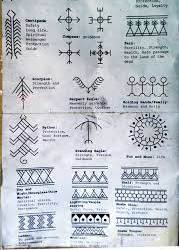
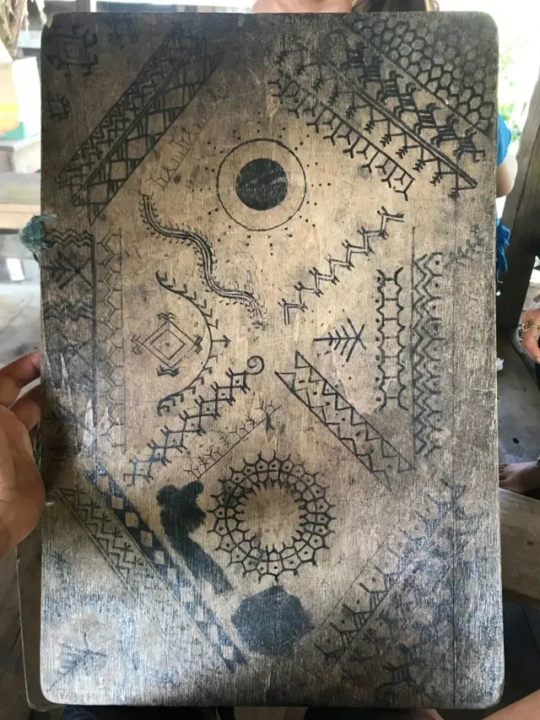
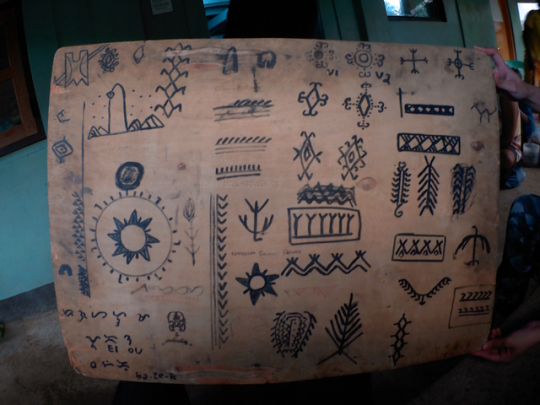
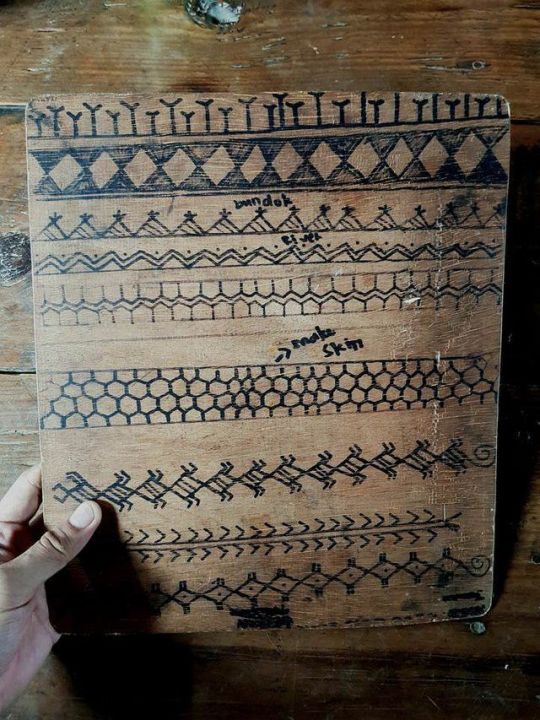
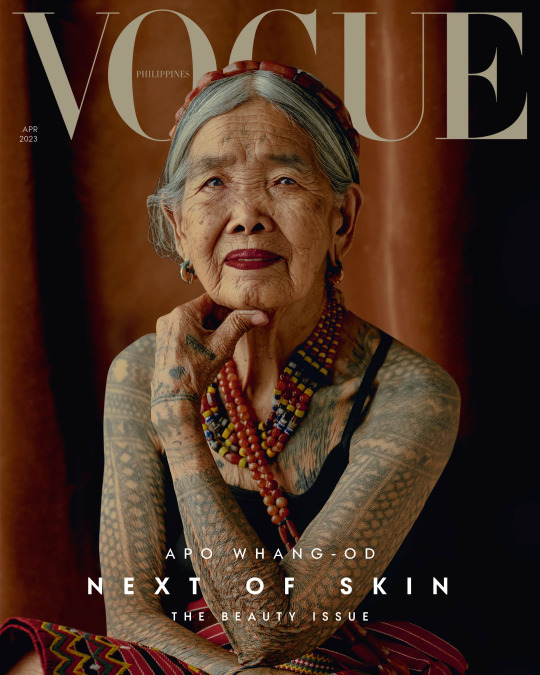
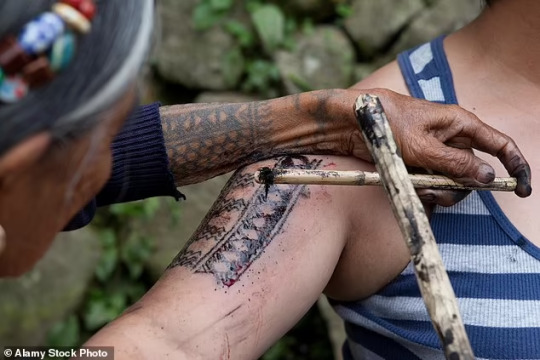
1 note
·
View note
Text
pit sarimanok
after all your complaints, we now reach the possible conclusion of the performance's meaning (and our consequent cultural forgetting of the thing). using the general transactional model of communication which emphasizes the role of feedback as simultaneous and indelible asset in meaning-making, and leaning on to Barthes' concept of mythology, i now posit that the text lies beyond the performance but in the fiasco.
much of the people on the internet call the performance out for misrepresenting the ethnolinguistic group. and a couple of days after the it was originally performed, the institution behind it publicly apologized through writing.
if the internet intellectuals had not called the performance and the choreographer/s out (the writer), it would have appeared that they agreed on the myth that the performance (the text) was re-presenting. but the opposite happened. many maranao muslims and outside of that culture alike judged the myth as wrong. and so, the simultaneous feedback (as the text was shown live, and still is alive as a meme) has been to correct it. the institution behind the performance, as it cannot be re-performed, admitted the error, and thus, re-establishing the myth that they unwittingly trampled.
viewing the whole thing under the lens of the transactional model of communication and Barthes' concept of myth, it appears that the interlocutor 1 (the writer), being the choreographer and later the institution, spoke of an erroneous myth through that performance (the text). simultaneously, as the interlocutor 2 (the reader) receives the erroneous myth, they correct it. i rather argue that it was simultaneous due to the rapid exchange of info through the internet. it would appear at this level that the text is the performance. but viewing where the myth lies (pun could be intended), and finally re-established, it appears that the real text is the fiasco.
the myth that is agreed by both writer and reader on the first level is this: that maranao muslims do not uphold the Sto Niño.
the second level myth, which is re-asserted in the fiasco is this: that maranao muslims are the subaltern in the mainstream filipino identity and that they should be defended from erroneous cultural appropriations. (i assert this paradigmatically since if Christian imagery is wrongfully appropriated, the Christians, by mere reacting, become the pathetic antagonist of the narrative instead of the wrongful appropriator.)
moreover, the second level myth is expressed though the reaction by the culturally guilty bourgeoisie hegemons who are eager to be an 'amicus' to the subaltern by showing that they, too, are offended.
and finally, the third level myth is that the maranao muslims are rather a cultural force to reckon with despite being considered a minority. thus, tread carefully when dealing with them. again, i say this rather paradigmatically since if this same incident is imagined with other cultural minorities, that performance would not gain so much negative reaction. say, the 'victimized' culture is the obo manobo, or the sama dilaut, or the badjaos, it would not have come to this. during kadayawan, for instance, free interpretation of cultural images borderline to parody and yet this kind of reaction has not been observed.
i do not dismiss the performance as text since all is text. rather, i point out that the myth-making (or myth-re-establishing) occurred in the fiasco rather than in the performance. thus, supporting the notion that the reader is part and parcel of meaning-making rather than solely present and given by the writer. in this case, the reader, as they react, become the poet. and those who react on that poiesis are also poets, furthering the hyperreal. all but contribute to the reaffirmation of agreed and sublated myths one way or another. these myths in turn form the building blocks, though in flux, of the national identity that is us, whether we like it or not.
and like all other historical realities in this part of the country, we are all going to forget about this. that was enough amicus.
0 notes